
Bucket A and block C are connected by a cable that passes over drum B. Knowing that drum B rotates slowly counterclockwise and that the coefficients of friction at all surfaces are μS = 0.35 and μk = 0.25, determine the smallest combined mass m of the bucket and its content for which block C will (a) remain at rest, (b) start moving up the incline, (c) continue moving up the incline at a constant speed.
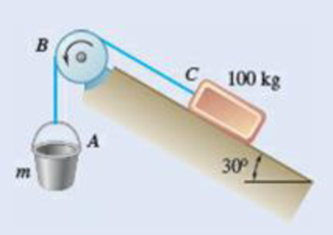
Fig. P8.118
(a)
Find the smallest combined mass m of the bucket for the block C will remain at rest.
Answer to Problem 8.118P
The smallest combined mass m of the bucket is
Explanation of Solution
Given information:
The mass of the block C is
The coefficient of static friction is
The coefficient of kinetic friction is
Calculation:
Show the free-body diagram of the drum B as in Figure 1.
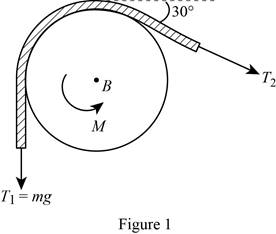
Find the angle of the belt wounded around the drum as follows;
Find the tension
Substitute mg for
Here, the acceleration due to gravity is g.
Consider the value of acceleration due to gravity is
Show the free-body diagram of the block C as in Figure 2.
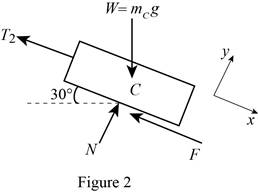
At rest, the cable slips on the drum. The motion impending is along the x-axis.
Substitute
Resolve the horizontal component of forces.
Substitute 100 kg for
Find the friction force (F) using the relation.
Substitute 0.35 for
Resolve the vertical component of forces.
Substitute
Therefore, the smallest combined mass m of the bucket is
(b)
Find the smallest combined mass m of the bucket for the block C start moving up the incline.
Answer to Problem 8.118P
The smallest combined mass m of the bucket is
Explanation of Solution
Given information:
The mass of the block C is
The coefficient of static friction is
The coefficient of kinetic friction is
Calculation:
Show the free-body diagram of the block C as in Figure 3.
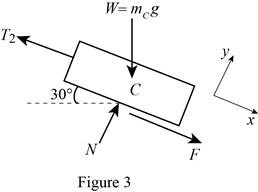
When the block start moving up the incline;
No slipping occurs at block and drum. The motion impending is against the x-axis.
Substitute
Resolve the horizontal component of forces.
Substitute 100 kg for
Find the friction force (F) using the relation.
Substitute 0.35 for
Resolve the vertical component of forces.
Substitute
Therefore, the smallest combined mass m of the bucket is
(c)
Find the smallest combined mass m of the bucket for the block C continue moving up the incline at constant speed.
Answer to Problem 8.118P
The smallest combined mass m of the bucket is
Explanation of Solution
Given information:
The mass of the block C is
The coefficient of static friction is
The coefficient of kinetic friction is
Calculation:
Show the free-body diagram of the block C as in Figure 3.
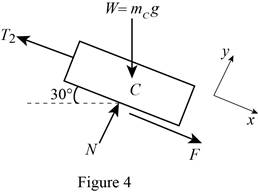
When the block start moving up the incline;
No slipping occurs at block and drum. The motion impending is against the x-axis.
Substitute
Resolve the horizontal component of forces.
Substitute 100 kg for
Find the friction force (F) using the relation.
Substitute 0.25 for
Resolve the vertical component of forces.
Substitute
Therefore, the smallest combined mass m of the bucket is
Want to see more full solutions like this?
Chapter 8 Solutions
Vector Mechanics for Engineers: Statics
- A recording tape passes over the 20-mm-radius drive drum B and under the idler drum C . Knowing that the coefficients of friction between the tape and the drums are μs= 0.40 and μk= 0.30 and that drum C is free to rotate, determine the smallest allowable value of P if slipping of the tape on drum B is not to occur.arrow_forwardKnowing that the coefficient of static friction between the tires and the road is 0.80 for the car as shown in figure 2. At this car, suddenly brakes are applied when it was moving with velocity of 360 inch/sec and it skidded to rest in 240 inch. Determine the magnitude of the normal reaction and of the friction force in the terms of W(weight) at each wheel as the car skidded to rest. { Use m=w/g, for the mass of the car if required, where g=386.09inch/s2.}arrow_forwardKnowing that the coefficient of static friction is 0.30 between the rope and the horizontal pipe and that the smallest value of P for which equilibrium is maintained is 80 N, determine (a) the largest value of P for which equilibrium is maintained, (b) the coefficient of static friction between the rope and the vertical pipe.arrow_forward
- A tractor-trailer rig with a 2000-kg tractor, a 4500-kg trailer, and a 3600-kg trailer is traveling on a level road at 90 km/h. The brakes on the rear trailer fail, and the antiskid system of the tractor and front trailer provide the largest possible force that will not cause the wheels to slide. Knowing that the coefficient of static friction is 0.75, determine (a) the shortest time for the rig to a come to a stop, (b) the force in the coupling between the two trailers during that time. Assume that the force exerted by the coupling on each of the two trailers is horizontal.arrow_forwardTwo 8-kg blocks A and B resting on shelves are connected by a rod of negligible mass. Knowing that the magnitude of a horizontal force P applied at C is slowly increased from zero, determine the value of P for which motion occurs and what that motion is when the coefficient of static friction between all surfaces is (a) μs= 0.40, (b) μs= 0.50.arrow_forwardQuestion: An 18-kg mass is hung from a lever which rests againsta 10 degree wedge at A and is supported by a frictionless pin at C.Knowing that the coefficient of static friction is 0.25 at bothsurfacees of the wedge and that for the position shown the springis stretched 100 mm, determine (a) the magnitude of the force P forwhich motion of An 18-kg mass is hung from a lever which rests againsta 10 degree wedge at A and is supported by a frictionless pin at C.Knowing that the coefficient of static friction is 0.25 at bothsurfacees of the wedge and that for the position shown the springis stretched 100 mm, determine (a) the magnitude of the force P forwhich motion of the wedge is impending, (b) the components of thecorresponding reaction at C.arrow_forward
- Solve Prob. 8.19 assuming that the coefficients of friction at B are zero.(Reference to Problem 8.19):Wire is being drawn at a constant rate from a spool by applying a vertical force P to the wire as shown. The spool and the wire wrapped on the spool have a combined weight of 20 lb. Knowing that the coefficients of friction at both A and B are μs=0.40 and μk= 0.30, determine the required magnitude of force P.arrow_forwardKnowing that the maximum friction force exerted by the bottle on the cork is 60 lb, determine (a) the force P that must be applied to the corkscrew to open the bottle, (b) the maximum force exerted by the base of the corkscrew on the top of the bottle.arrow_forwardKnowing that the coefficient of friction between the 25-kg block and the incline is μs= 0.25, draw the free-body diagram needed to determine both the smallest value of P required to start the block moving up the incline and the corresponding value of β.arrow_forward
- A 16-lb spool is at rest on an inclined surface. Around its center a cable is wound which travels with the same inclination of the ramp, passes through a frictionless pulley, and is attached to a block B at its other end.The coefficient of static friction between block B and the floor is 0.25. For the position shown, with the given value of α, determine: R (in) = 11,1 in r (in) = 7 in α (°) = 16° 1. The minimum coefficient of static friction that must exist between the reel and the floor of the ramp, so that the reel does NOT slide on the ramp (does not slip). 2.The minimum weight that block B must have for the reel to NOT roll down the ramp dragging block B. Do not allow for the possibility of the block turning or tipping over.arrow_forwardTwo slender rods of negligible weight are pin-connected at C and attached to blocks A and B , each with a weight W . Knowing that P = 1.260 W and that the coefficient of static friction between the blocks and the horizontal surface is 0.30, determine the range of values of 0 between 0 and 180° for which equilibrium is maintained.arrow_forwardTwo blocks A and B are connected by a cable as shown. Knowing that the coefficient of static friction at all surfaces of contact is 0.30 and neglecting the friction of the pulleys, draw the free-body diagrams needed to determine the smallest force P required to move the blocks.arrow_forward
 Elements Of ElectromagneticsMechanical EngineeringISBN:9780190698614Author:Sadiku, Matthew N. O.Publisher:Oxford University Press
Elements Of ElectromagneticsMechanical EngineeringISBN:9780190698614Author:Sadiku, Matthew N. O.Publisher:Oxford University Press Mechanics of Materials (10th Edition)Mechanical EngineeringISBN:9780134319650Author:Russell C. HibbelerPublisher:PEARSON
Mechanics of Materials (10th Edition)Mechanical EngineeringISBN:9780134319650Author:Russell C. HibbelerPublisher:PEARSON Thermodynamics: An Engineering ApproachMechanical EngineeringISBN:9781259822674Author:Yunus A. Cengel Dr., Michael A. BolesPublisher:McGraw-Hill Education
Thermodynamics: An Engineering ApproachMechanical EngineeringISBN:9781259822674Author:Yunus A. Cengel Dr., Michael A. BolesPublisher:McGraw-Hill Education Control Systems EngineeringMechanical EngineeringISBN:9781118170519Author:Norman S. NisePublisher:WILEY
Control Systems EngineeringMechanical EngineeringISBN:9781118170519Author:Norman S. NisePublisher:WILEY Mechanics of Materials (MindTap Course List)Mechanical EngineeringISBN:9781337093347Author:Barry J. Goodno, James M. GerePublisher:Cengage Learning
Mechanics of Materials (MindTap Course List)Mechanical EngineeringISBN:9781337093347Author:Barry J. Goodno, James M. GerePublisher:Cengage Learning Engineering Mechanics: StaticsMechanical EngineeringISBN:9781118807330Author:James L. Meriam, L. G. Kraige, J. N. BoltonPublisher:WILEY
Engineering Mechanics: StaticsMechanical EngineeringISBN:9781118807330Author:James L. Meriam, L. G. Kraige, J. N. BoltonPublisher:WILEY





